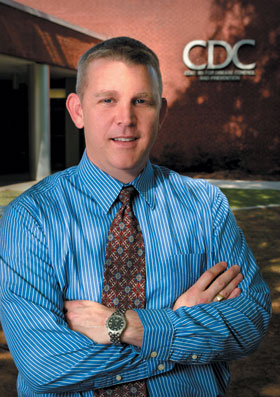| Defining the brand | Advertising the brand | Living the brand |
| Home Forethought President's Message Campus Buzz Feature Stories Re:Search The Score Alum News Yesteryear | ||
|
|
“We were there to help, but the villagers associated us with death and disease,” recalled Dr. Montgomery, one of 12 CDC epidemiologists dispatched to Angola in April 2005 as part of a World Health Organization team responding to the world’s worst outbreak of Marburg hemorrhagic fever in history.
Marburg is a virus similar to Ebola that spreads through contact with contaminated body fluids. It kills at an alarming rate—nearly 90 percent in Angola—because there is no cure or effective treatment. All a health care worker can do is place victims in isolation to prevent further spread of the virus and make them as comfortable as possible.
Montgomery spent nearly three weeks in small villages in Angola’s impoverished U�ge province. People live in mud-brick huts without proper sanitation and have limited access to health care after nearly three decades of civil war. He found Angola’s infrastructure in shambles, the countryside littered with land mines, and the hospitals at the center of the outbreak zone had no water or electricity.
He watched people shake from fever, suffer severe headaches, diarrhea and nausea, then bleed out before dying. He saw parents bury their children in traditional ceremonies that involved kissing the dead which may have further contributed to the spread of the illness.
“We have to help the people develop an understanding of how and why an outbreak occurs,” Montgomery said. The initial source for the Marburg epidemic in Angola remains unknown; however, local health workers who reused needles to inject vitamin B complex and faith healers who used dirty razor blades for scarring rituals likely contributed to transmission.
The WHO recruited cultural leaders and healers to help ease the villagers’ fear and change their attitude toward those who had come to help. But not before Montgomery and his fellow workers were attacked with rocks and big knives.
“It’s stressful, chaotic and dangerous work,” said Montgomery, who holds bachelor’s, master’s and doctorate degrees in biology from UT Arlington. Part of the stress comes from having to leave his wife, Kim, and son, Van, behind with almost no warning. The trip to Angola was especially hard because Van was only 3 months old.
“It was tough to leave before we had a child. Now it’s harder,” Montgomery said. “But it is valuable and important for the safety and well-being of the global community.”
He believes more outbreaks like this one are possible because new viruses are developing each year.
“We’re seeing more because of increasing human population density. There is a greater chance of spillover into areas where humans are coming into more contact with animals. We encroach on their habitats. We disturb their environments by cutting down trees to grow crops, such as sugar cane and corn. As this happens, we will continue to see more and more contact and increased transmission of disease.”
Montgomery will leave his current job with the Special Pathogens Branch at CDC later this year to take a position as the CDC liaison to the U.S. Naval Medical Research Center Detachment in Peru. This time his wife and son will be with him. He will be there for up to five years studying infectious diseases throughout South America.
— Becky Purvis
| Archives
| Alumni Association |
Giving to UT Arlington | UT
Arlington Home Copyright © 2006 UT Arlington Magazine. All rights reserved. |

